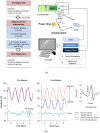Fatigue effect on low-frequency force fluctuations and muscular oscillations during rhythmic isometric contraction
- PMID: 24465605
- PMCID: PMC3897466
- DOI: 10.1371/journal.pone.0085578
Fatigue effect on low-frequency force fluctuations and muscular oscillations during rhythmic isometric contraction
Abstract
Continuous force output containing numerous intermittent force pulses is not completely smooth. By characterizing force fluctuation properties and force pulse metrics, this study investigated adaptive changes in trajectory control, both force-generating capacity and force fluctuations, as fatigue progresses. Sixteen healthy subjects (20-24 years old) completed rhythmic isometric gripping with the non-dominant hand to volitional failure. Before and immediately following the fatigue intervention, we measured the gripping force to couple a 0.5 Hz sinusoidal target in the range of 50-100% maximal voluntary contraction. Dynamic force output was off-line decomposed into 1) an ideal force trajectory spectrally identical to the target rate; and 2) a force pulse trace pertaining to force fluctuations and error-correction attempts. The amplitude of ideal force trajectory regarding to force-generating capacity was more suppressed than that of the force pulse trace with increasing fatigue, which also shifted the force pulse trace to lower frequency bands. Multi-scale entropy analysis revealed that the complexity of the force pulse trace at high time scales increased with fatigue, contrary to the decrease in complexity of the force pulse trace at low time scales. Statistical properties of individual force pulses in the spatial and temporal domains varied with muscular fatigue, concurrent with marked suppression of gamma muscular oscillations (40-60 Hz) in the post-fatigue test. In conclusion, this study first reveals that muscular fatigue impairs the amplitude modulation of force pattern generation more than it affects the amplitude responsiveness of fine-tuning a force trajectory. Besides, motor fatigue results disadvantageously in enhancement of motor noises, simplification of short-term force-tuning strategy, and slow responsiveness to force errors, pertaining to dimensional changes in force fluctuations, scaling properties of force pulse, and muscular oscillation.
Conflict of interest statement
Figures




Similar articles
-
The use of non-linear tools to analyze the variability of force production as an index of fatigue: A systematic review.Front Physiol. 2022 Dec 14;13:1074652. doi: 10.3389/fphys.2022.1074652. eCollection 2022. Front Physiol. 2022. PMID: 36589460 Free PMC article.
-
Trajectory adjustments underlying task-specific intermittent force behaviors and muscular rhythms.PLoS One. 2013 Sep 30;8(9):e74273. doi: 10.1371/journal.pone.0074273. eCollection 2013. PLoS One. 2013. PMID: 24098640 Free PMC article.
-
Influence of fatigue on hand muscle coordination and EMG-EMG coherence during three-digit grasping.J Neurophysiol. 2010 Dec;104(6):3576-87. doi: 10.1152/jn.00583.2010. Epub 2010 Oct 6. J Neurophysiol. 2010. PMID: 20926609 Free PMC article.
-
Effects of dual-task demands on the complexity and task performance of submaximal isometric handgrip force control.Eur J Appl Physiol. 2020 Jun;120(6):1251-1261. doi: 10.1007/s00421-020-04357-x. Epub 2020 Apr 3. Eur J Appl Physiol. 2020. PMID: 32242254 Clinical Trial.
-
Physiological complexity: influence of ageing, disease and neuromuscular fatigue on muscle force and torque fluctuations.Exp Physiol. 2021 Oct;106(10):2046-2059. doi: 10.1113/EP089711. Epub 2021 Sep 14. Exp Physiol. 2021. PMID: 34472160 Review.
Cited by
-
The use of non-linear tools to analyze the variability of force production as an index of fatigue: A systematic review.Front Physiol. 2022 Dec 14;13:1074652. doi: 10.3389/fphys.2022.1074652. eCollection 2022. Front Physiol. 2022. PMID: 36589460 Free PMC article.
-
Paradigm Shifts in Voluntary Force Control and Motor Unit Behaviors with the Manipulated Size of Visual Error Perception.Front Physiol. 2017 Mar 13;8:140. doi: 10.3389/fphys.2017.00140. eCollection 2017. Front Physiol. 2017. PMID: 28348530 Free PMC article.
-
Risk of postpartum hemorrhage and fetal gender.Arch Gynecol Obstet. 2023 Jul;308(1):313-314. doi: 10.1007/s00404-022-06723-w. Epub 2022 Oct 10. Arch Gynecol Obstet. 2023. PMID: 36214889 No abstract available.
-
Influence of muscle fatigue on electromyogram-kinematic correlation during robot-assisted upper limb training.J Rehabil Assist Technol Eng. 2020 Mar 16;7:2055668320903014. doi: 10.1177/2055668320903014. eCollection 2020 Jan-Dec. J Rehabil Assist Technol Eng. 2020. PMID: 32206337 Free PMC article.
-
The Impact of Fatigue on the Sense of Local and Global Rhythmic Movement.J Hum Kinet. 2023 Jan 20;86:51-61. doi: 10.5114/jhk/159604. eCollection 2023 Mar. J Hum Kinet. 2023. PMID: 37181260 Free PMC article.
References
-
- Huang CT, Hwang IS, Huang CC, Young MS (2006) Exertion dependent alternations in force fluctuations and limb acceleration during sustained fatiguing contraction. Eur J Appl Physiol 97: 362–371. - PubMed
-
- Huang CT, Huang CC, Young MS, Hwang IS (2007) Age effect on fatigue-induced limb acceleration as a consequence of high-level sustained submaximal contraction. Eur J Appl Physiol 100: 675–683. - PubMed
-
- Masuda K, Masuda T, Sadoyama T, Inaki M, Katsuta S (1999) Changes in surface EMG parameters during static and dynamic fatiguing contractions. J Electromyogr Kinesiol 9: 39–46. - PubMed
-
- Mottram CJ, Jakobi JM, Semmler JG, Enoka RM (2005) Motor-unit activity differs with load type during a fatiguing contraction. J Neurophysiol 93: 1381–1392. - PubMed
-
- Taylor JL, Gandevia SC (2008) A comparison of central aspects of fatigue in submaximal and maximal voluntary contractions. J Appl Physiol 104: 542–550. - PubMed
MeSH terms
LinkOut - more resources
Full Text Sources
Other Literature Sources

